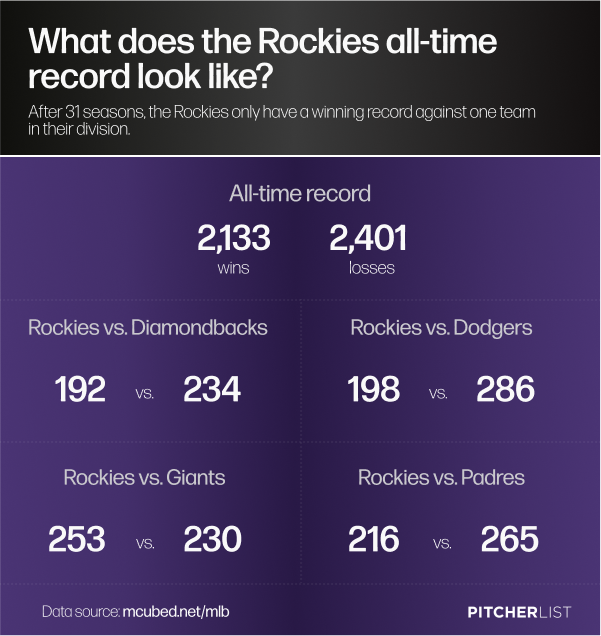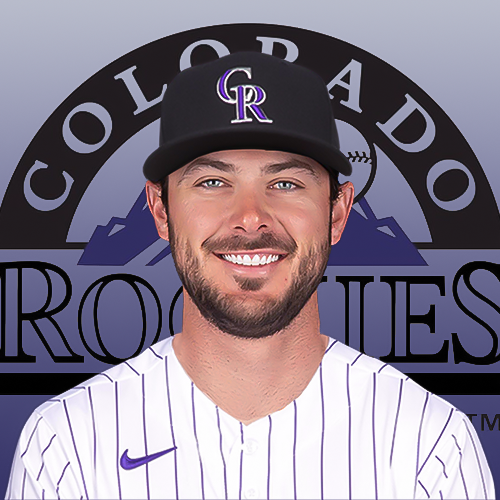We can use many adjectives to try and describe how the Colorado Rockies have left us feeling after this past year. Some words that come to mind are confused, infuriating, disappointed, or sometimes even excited? Either way, it seems as if the Rockies might be just as lost as the rest of us.
When you look at other teams around the league, it’s easy to see the A’s and Reds’ direction. The same goes for the opposite approach of the Mets and Dodgers.
The History
The Colorado Rockies joined Major League Baseball, as an expansion franchise, back in 1991 when they were awarded to John Antonucci. They kicked off their inaugural season in 1993.
Since then, the Rockies have reached the postseason five times, each as the Wild Card representative for the National League. In those four trips, two ended in first-round exits and one took them to the World Series in 2007, where they were then swept by the Boston Red Sox.

Created by @visual_endgame on Twitter.
The true era of the Rockies, arguably, began in 1997 when Todd Helton, the team’s first-round pick in 1995, made his debut for the team. Jim Leyland was brought in as the manager in 1999 and left the Rockies-faithful hopeful for brighter days ahead. Throughout the years, the Rockies have had high-profile players such as Troy Tulowitzki, Vinny Castilla, Larry Walker, and Matt Holiday penciled into their lineup.
The “Coors Effect”
Believe it, or not, there is an exact definition of the Coors Effect. It is known as the great increase in offense and scoring, relative to other major-league venues. The exact effect is due to the altitude of the city of Denver. The lower air pressure at the mile-high altitude of Denver lessens air resistance on batted balls, allowing the baseballs to fly farther.
However, hitting is not the only thing that is impacted by the thin air. Breaking pitches are known to have less “bite” to them, meaning that the pitches move less and become more hittable. David Kotin at BaseballCloud Blog researched the direct effect that the thin air has on pitch speeds and spin rates from pitchers both in and out of Coors. The biggest split that he found was the effect on sinkers. Kotin noticed an increase in spin rate around 4%. Meanwhile, the velocity on pitchers’ fastball decreased by 0.5% in Denver. This research showed that there actually wasn’t much of an impact on pitch speed or spin rates. The notable result came from vertical and horizontal movement. Fastballs had the largest difference with a separation of 3.1 inches. This meant that fastballs had 3.1 inches more drop at Coors Field. Cutters and sliders also had less horizontal movement. In summary, Coors lead to the less generated movement for pitches resulting in both a decrease in fastball rise and less curveball break.
In a study done by Mike Petriello at MLB.com, in 2019, he took a look at previous Rockies’ performance on the road, compared to playing in Colorado. One of the statistics found was that there was a team-wide gap in strikeout rates, 18.5% at home, compared to 23.9% in 2015.
In the 17-year history of the implementation of the humidor installed at Coors Field, the standard deviation of the home-road difference for Rockies batters is 8.66. The biggest split was +23.4 points in 2014, and as low as -10.9 points in 2011.
The Highs
#Walkoff HR……TO COMPLETE THE CYCLE?
Have a day, Nolan Arenado. pic.twitter.com/5roQtSOa6C
— Stadium (@Stadium) June 18, 2017
Not long ago, the Rockies were one of the more exciting teams in Major League Baseball, even if they have found themselves competing in one of the tougher divisions in baseball. They were able to develop one of the better home-grown cores with hitters such as Nolan Arenado, Trevor Story, and Charlie Blackmon. You can then add the arms that have been successful for them in Germán Márquez, Jon Gray, and Kyle Freeland.
Their World Series run in 2007 was one to remember. They went on to win 14 of their final 15 games and made the playoffs as the NL Wild Card team. This run was made on the backs of outfielder Matt Holiday, first baseman Todd Helton, and All-Star relief pitcher Brian Fuentes.
The Lows
The Rockies are no strangers to tear-downs. It started back in 1999 when the team’s only General Manager to date, Bob Gebhard, resigned, and the team named Dan O’Dowd as his replacement.
After bringing in Buddy Bell to manage the ball club, O’Dowd proceeded to make a series of offseason moves that altered the face of the franchise. Dante Bichette was traded to Cincinnati, Vinny Castilla was dealt to the Tampa Bay Devil Rays, and Darryl Kile was sent the Cardinals. This left Larry Walker as the only remaining member of the “Blake Street Bombers.” Then, in 2015, the Rockies traded away their cornerstone shortstop, Troy Tulowitzki.
This team has also struggled to make a positive impact on free-agent signings over the years. Players such as Wade Davis (3 years/$52M), Ian Desmond (5 years/$70M), and the double-barreled bullpen pieces of Bryan Shaw and Jake McGee (3 years/$27M) just have not panned out the way they were expecting for them too. Then, since signing his $108 million extension with the team, Charlie Blackmon has not been the same player, sporting a lowly 94 wRC+, and 13 home runs, in 150 games last season.
The final shot to the fanbase came when the team decided to move on from Nolan Arenado during the 2021 off-season, only two seasons after they awarded him an eight-year, $260 million extension. The biggest part of this was that they agreed to pay $50 million of this deal for him to play for the Cardinals. They now find themselves on the precipice of losing Trevor Story after not trading him this past deadline. The Rockies even let Jon Gray move onto the Texas Rangers after turning down multiple trade offers for him.
What’s Next?

The Rockies shocked the baseball world when they decided to invest $182 million, over seven years, to Kris Bryant. The new contract includes a full no-trade clause and no opt-out clause.
This new contract comes after paying for their former third baseman to play for another team, having their All-Star shortstop hint at there not being enough money to keep him in a Rockies jersey, and having their owner fighting to keep the luxury tax threshold as low as possible throughout the lockout negotiations. The team also decided they were ready to move on from Scott Van Lenten, the head of analytics, only six months after hiring him for the position.
Bryant has not been the only signing that the team has made this offseason, but he is the most notable. José Iglesias, Jhoulys Chacín, Alex Colomé, and Chad Kuhl were all brought in on one-year deals. None of those seem to be the type of impact signings that signal they are ready to compete this season.
Is this long-term investment a sign that this is a play to compete within the next couple of seasons? Perhaps. However, there is still the chance that this high-profile third baseman follows in the same path as the one that he is replacing.
In the end, we are all sharing the same sentiment about this team. Are there still more moves coming to help them compete this season? Is this long-term deal one that they are looking at as a play to wait out the fall of their division-mates in Los Angeles and San Francisco? It seems as if we’re just going to have to wait a little longer to see how this plays out. The Rockies are no strangers to pulling off the more surprising moves, so let’s not dismiss the chances of more on the horizon.
Photo by Nick Wosika/Icon Sportswire | Adapted by Michael Packard (@artbyMikeP on Twitter & IG)
